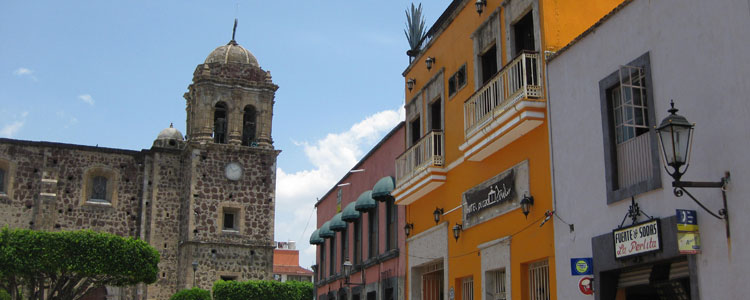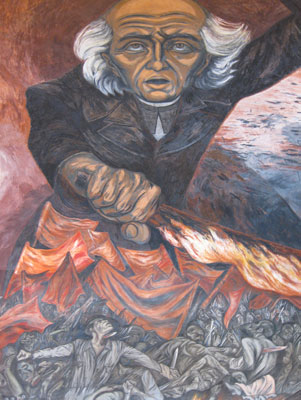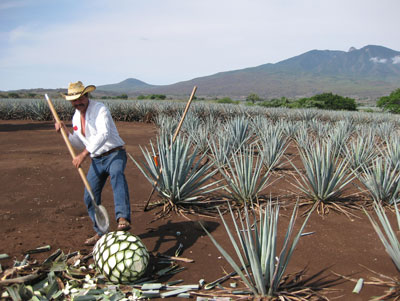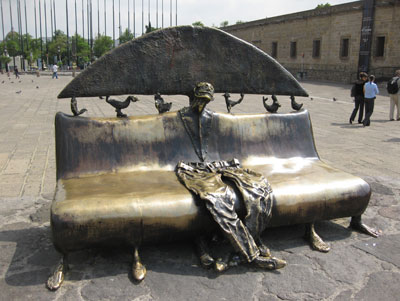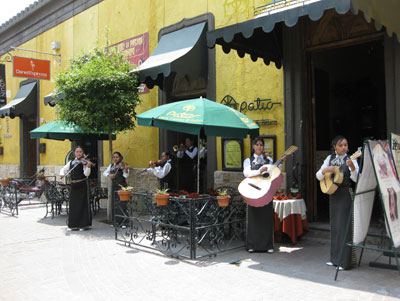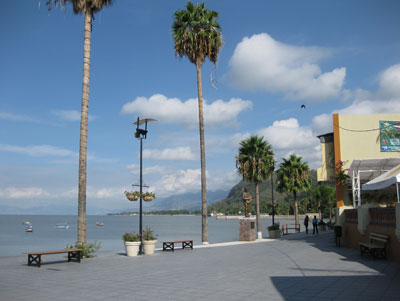Finding art, good food and the home of tequila in Mexico’s state of Jalisco
by Dorothy Aksamit, Sausalito, CA
We had canceled a trip to Cancun in May ’09 amid the flood of coverage on the “swine flu,” but I knew of only one 30-something friend who had been diagnosed with the H1N1 virus so, since the world seemed to be tilting dizzily in all directions anyway, two friends and I decided a trip to Mexico would be the perfect antidote after all.
One of my travel companions, Maria, had a friend in Guadalajara who would meet us at the airport and be our driver-guide until she put us on a plane to Puerto Vallarta, where we would be on our own. The plan was to check out Jalisco, visiting places we’d been and places we hadn’t.
Settling in
Our Mexicana flight from San Francisco’s typical gray summer sky to sunny Los Cabos was filled with happy, laughing gringo families clutching teddy bears, inflatables and pillows. There was no whiff of pandemic or recession.
After a quick change of planes, and with barely six hours of elapsed time from San Francisco, we were in Guadalajara.
At the Guadalajara Plaza Hotel (Ave. Mariano Otero No. 3261; www.hotelesgdlplaza.com.mx), chosen for its small size and blissful quiet ($98, double), we went immediately to the fourth floor for a quick, solitary swim in the small pool with a view.
That night we had a scrumptious meal at Argentilia (Ave. Américas 840; phone 36401498). Its inviting patio was in danger of a deluge, as the sky had been overcast all day, so we chose a table inside as the small restaurant quickly filled with locals.
My pear salad, with thin slices of pear atop baby greens interspersed with strawberries, candied pecans and Roquefort dressing, made me think I should just quit there — that is, until the grilled beef arrived, fork tender and succulent.
Dessert proved too tempting, so we went on overload, ordering crêpes with blackberry ice cream and walnuts. This was a memorable meal ($35 per person)!
Exploring Guadalajara
A green tourist bus stops near the hotel and goes to Government Palace, Tlaquepaque and Tonalá for around $1.
Days could be spent in Guadalajara’s historic center visiting its palaces, cathedrals and museums, but I always head straight for Government Palace (free entry), where Orozco’s 1937 murals, in all their violent fury, challenge the observer to enter his world of social struggle. As you approach the grand staircase, the Father of Mexican Independence, Hidalgo, holding a flaming torch in one hand, seems to leap right off the wall ready to fight the forces of evil that are crushing the struggling masses below.
The colors are of the earth, predominantly blacks and grays accented with umbers and red and illuminated with white. Other panels illustrate Orozco’s biting satire of false religions, false leaders and false ideologies.
Outside on the long walk between Government Palace and Cabañas Hospice, we saw more strolling art vendors and ice cream wagons than tourists. We stopped for photos at the massive Quetzalcoatl Fountain and the whimsical bronze chairs of Alejandro Colunga that invite the viewer to sit in the embrace of the magician who has melted into the chair.
The beautiful Cabañas Hospice, with 23 patios and 106 rooms, was a home for poor orphans from 1845 until 1980. In the late 1930s, Orozco worked for four dollars a day (I was told) on the murals that decorate the walls and ceiling of its chapel.
We joined a tour ($7) led by Erubey, who raced from one end of the entrance hall to the other, proving to us that Orozco was a genius of perspective. Under Erubey’s guidance, we saw converging lines become straight and eyes that followed us as we moved from right to left.
Finally, to steady ourselves we each put a hand on the shoulder of the person in front of us and, gazing up at the cupola, slowly circled Orozco’s famous “Man on Fire.” The “man,” rising above figures that represent earth, air and water, writhed in flames.
This was the first time I had seen the murals with so few tourists, giving me time to discover previously overlooked details.
Back in the real world it was time for lunch, and we chose the columned, indoor/outdoor El Nahual (Juarez St. No. 17) in nearby Tlaquepaque. El Nahual, with its copious artwork covering every nook and cranny, could easily pass for a museum.
We dined alone, which was a shame, as the pesto fettuccine with shrimp and the duck in black mole were just right. Our meal cost around $25 each.
After returning to the hotel, we left for nearby Zapopan to see the tiny wooden Virgin of Zapopan, brought from France by the Franciscans and given to the Indians in 1542. Alas, that was not to be.
We should have gone to the basilica first because after visiting the Municipal Palace to see the mural of artist Guillermo Chávez Vega, there was a deafening thunderclap followed by torrential rain. Zapopan is charming, with plazas, gardens and pedestrian walkways, and it is on my list for my next visit.
Tequila
The next day the rain-washed skies beckoned us to explore Tequila, home of Mexico’s world-famous spirit.
The highlight of my repeat journey there was a brief visit to a blue agave field where Ismael Gama, machete and coa (a heavy hoe with a round blade) in hand, made quick work of digging up a 50-pound agave and separating out a small shoot to demonstrate that by planting the shoot, the agave would be ready for harvest in eight to 10 years.
In a flash, Ismael was surrounded by fleshy leaves with wicked spikes, and the pina, the naked heart of the agave, was exposed. Ismael has been working as a jimador, or agave-field worker, since he was seven years old.
Our guide, Angelica, pointed out that his hands, after 38 years of working in the field, were as soft as a baby’s. Ismael told us the secret of his soft hands: a cream using lard and, for fragrance, the essence of the agave — and, by chance, he had jars of the handmade cream for sale. (It was later that I learned he was also a model, appearing in all the José Cuervo ads that feature a jimador.)
Touring and tasting
Tequila’s streets were oddly quiet. When we got to Mundo Cuervo we found that, because it was not the harvest season, the distillery, La Rojeña, was not in operation. However, that didn’t hinder our immediate immersion in the opulence of colonial Mexico.
Columns, arches, tiled patios housing art collections, antique cars and a black crow in a huge iron cage illustrated José Cuervo’s motto that “Art and culture go hand in hand with the history of Tequila.”
We took the “classic tour” ($10), which included four tastings and a margarita at the end. I enjoyed the tour without the distraction of the machinery noise — I could hear the guide and the tour went quickly. We saw steel fermentation vats, copper distillation vats and oak barrels, imported from America and France, stacked to the ceiling.
Standing beside split barrels with variously charred interiors, we tasted the clean, earthy blanco, bottled within 60 days of distillation, the reposado, which had “rested” in oak barrels two to six months, and the añejo, the choice of connoisseurs, aged in wood for a year or more.
I couldn’t wait to get to Fonda Cholula, Mundo Cuervo’s restaurant, for a repeat of one of my favorite dishes, chile en nogada. This culinary celebration of Mexico’s victory over the French looks simple — a green pepper filled with a white nut sauce and sprinkled with red pomegranate seeds (the colors of the Mexican flag) — but it requires a daunting 38 ingredients. I added a nopal (prickly pear cactus) salad, a great foil to the sweetness of the entrée ($25, total).
Small town visits
We were back at the hotel’s swimming pool by 4:30 planning the next day’s trip to Puerto Vallarta. Scheduled for an afternoon flight, we would have time for a quick look at the towns of Chapala and Ajijic before leaving.
Both towns have such a large expat population of Americans and Canadians that I had never before considered them as long-term-stay possibilities but, then, I had never been to either town. However, after strolling down the Malecón in Chapala, I began to think, ‘What’s not to like?’
Recent improvements included doubling the length of the Malecón, planting new palms and installing new benches and ornate streetlights, and renovations are still underway.
Ajijic’s Malecón was also undergoing renovations, but they were not quite as far along. We were in the mood for comfort food, so everyone had club sandwiches under the huge palapa at the Camino Real.
Puerto Vallarta
When we arrived in Puerto Vallarta, a symphony of cicadas greeted us in the open-air lobby of the CasaMagna Marriott (Paseo La Marina 435; phone 888/236-2427, www.marriott.com). In fact, after I spotted a large iguana near a water feature and saw the first turtle of the season laboriously making her way onto Marriott’s beach, I began to think of the Marriott as a wildlife sanctuary. The hotel is within walking distance of the marina.
A wedding party filled the lobby bar the first night, and the next day weekenders began to arrive, so it wasn’t apparent that this hotel was way below capacity. We booked a nonflexible (date-locked-in) rate of $119 for a double room. The breakfast buffet cost an additional $25.
Still, the breakfast bar, as large as some restaurants, offered an around-the-world selection of items. My favorite was the tamales Oaxacanos — silky masa steamed with a little pork and wrapped in a banana leaf. There was also a sweet version, with sugar, cinnamon and raisins, wrapped in a corn husk. My juice was emerald green, a blend of pineapple, grapefruit, celery and cilantro — sounds gross, but it was light and refreshing.
Day tours
At the Marriott, we joined five other hotel guests for the “Jungle Canopy Tour” to Chico’s Paradise ($200 for eight) plus a zip-line adventure. I skipped the zip-line (which cost an additional $80) and, instead, had a surprisingly good seafood lunch ($25) while zip-liners screamed as they flew over the canyon and river.
While eating, I was entertained by a daring local who, from a rock outcrop on the river, took a flying leap before somersaulting into a perfect swan dive into the river. That was worth the price of admission.
Make sure you take enough cash for the zip-line, lunch and tips, as credit cards are not accepted.
It’s always fun to sneak a peek at the private enclaves of the rich and famous, so my favorite tour was to the lush, private paradise of John Huston, who discovered Las Caletas while he was directing the movie “The Night of the Iguana.” Today, Vallarta Adventures runs the property.
We booked our tour through the Marriott, then boarded a spiffy catamaran at Puerto Vallarta and began an orgy of eating and drinking, enjoying bottomless mai tais, pastries, fruit and coffee plus an energetic entertainment crew.
Las Caletas is in a lush jungle setting with crystal-clear water, palapa dining rooms and flashes of brilliant red and green parrots sweeping over the beach. We swam, snorkeled, kayaked and caught the paella demonstration near the beach.
All the ingredients had been prepped, so Chef Redham’s huge wok was soon filled with sautéed tomatoes, peppers, onions, fish bouillon, white wine, parboiled rice, shrimp, squid, clams, mussels and spiny lobsters. We were salivating, but when the dish was finished, the wok was wrapped in foil and whisked to the dining room to join the bountiful buffet.
At the buffet, we passed on the salads, chicken and ribs, saving our plate for the paella, which was superb.
The tour cost of $85 was all-inclusive.
A big finish
For our grand finale, we went to the turreted little restaurant Café des Artistes (Guadalupe Sánchez 740). It was recommended by the Marriott, but we were not expecting such a lavish experience.
Threatening skies kept us out of the leafy patio, but the main dining room was also charming, with huge oil paintings, intimate alcoves, a water feature and a welcoming piano bar.
Settling in for a most sophisticated dining experience, we were presented with two amazing dishes: grilled beef tenderloin petals with crispy, paper-thin potatoes, Camembert cheese and chipotle chili sauce followed by a dessert sampler served on a crystal plate decorated with chocolate swirls and spun sugar and consisting of a concentrated hot chocolate shot, mango sherbet, apple pastry and mango-passion fruit crème brûlée.
Our three-course fixed-menu meal cost $40 each. Celebrity chef Thierry Blouet added extra sparkle to the evening as he greeted celebrating patrons.
We were sorry we didn’t have time for more “research.” What we found was that the markets were sadly empty of tourists but the more upscale restaurants were doing well and the tours we took seemed to be popular. We were very glad we had made the trip.

